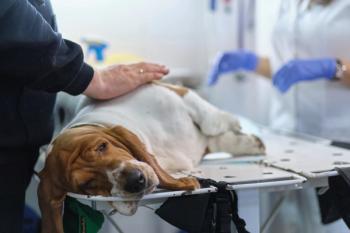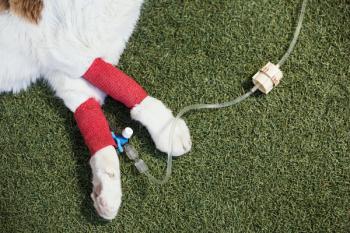
Teams rescue animals caught in multi-state floods
The town of Miami, Okla., was among the areas hardest hit by floodwaters that ravaged parts of Kansas, Oklahoma, Missouri and Texas from May through early July, killing 14 people, displacing some 500 animals and raising the specter of long-term health problems for those that survived.
NATIONAL REPORT — State animal-response teams and rescue organizations deployed to assist the cluster of Central states hit hardest by recent floods that left the long-term health of impacted animals in question.
After the deluge: Flooded street in Miami, Okla., on July 3, before the floodwaters had even crested.
Flooding joins severe winter storms and tornadoes to complete a trifecta of severe weather to hit the nation's midsection this year.
The most recent bout with Mother Nature spread across Kansas, Oklahoma, Missouri and Texas, leaving officials struggling to keep people, animals and rescue efforts above water.
More than an entire month of incessant rainfall, beginning in late May and continuing through early July, left about 500 animals displaced in the hardest-hit areas, and at least 14 people dead across the four states, with thousands more currently without homes or facing extensive property damages.
Floodwaters poured through city streets, sewers, homes and businesses, contaminating food and drinking water. The impact to animal health remains largely unknown, yet a primary concern to veterinarians.
"We pulled a lot of animals out of contaminated water," which smelled like petroleum throughout areas of Oklahoma, says Tracy Reis, Animal Emergency Services program manager with the American Humane Association (AHA), called in to assist rescue and shelter efforts. "We may see an increase in digestive and pulmonary disorders. We've had quite a bought with diarrhea, and we don't know the long-term health effects."
Despite enduring multiple weather disasters this year, Kansas officials fear the recent floods may have caused the most widespread and costly devastation.
"This will prove to be a very major disaster because it covers such a wide area. Overall, the flooding has been more disastrous than other storms we've had, just because of the wide involvement," says George Teagarden, livestock commissioner for the Kansas Animal Health Department.
Helping the homeless
Rainfall doubling normal amounts separated many animals from their homes and owners, and left several animal shelters flooded. Facilities that escaped water damage in the hardest-hit areas — Miami and Bartlesville, Okla., and Coffeyville, Kan. — were overwhelmed.
The Miami Animal Welfare Society is housing 100 dogs and cats from the flood, in addition to the 30 animals already boarded there before the storms, says Scott Mason, DVM and program coordinator for the medical reserve core of the Oklahoma State Animal Response Team (SART), sponsored by the Oklahoma Veterinary Medical Association.
After an unprecedented 20 straight days of rain, Oklahoma floods eventually forced the Washington County Society for the Prevention of Cruelty to Animals in Bartlesville to set up a temporary shelter at the Dewey Agriculture Center in Dewey, Okla. "But they have not had any evacuation problems or veterinary issues," Mason says.
While only three companion animals — two dogs and one cat — were reported dead in the area, the state's population of agricultural animals was harder hit. Thirty cattle reportedly drowned from one flooded farm just before July 4, Reis says.
Some farm animals caught in high waters through Texas and Missouri were relocated to drier areas, but few if any deaths or overloaded shelters were reported.
"We have helped move a few animals. There were several horses and some miniature donkeys in the Houston area that were in the way of floodwaters. But there haven't been massive numbers," says Carla Everett, Texas Animal Health Commission public information director.
Mixing oil and water
Flooding was not the only concern for residents of Coffeyville, Kan., home of the Coffeyville Resources refinery. A pumping malfunction caused 42,000 gallons of crude oil to spill into south-central Kansas' Verdigris River, coating property, rescue workers and pets.
With more than an estimated 400 animals impacted by water and oil floods, the Coffeyville Animal Control Department has been working around the clock, assisting all types of species, including ferrets, snakes, mice, dogs, cats and rabbits, says Director Devin Volmer.
"Animals hit by the flood are saturated with oil. Right now the waters have receded, but we still have a lot of animals we need to get decontaminated," says Volmer, who categorized the flood as "a really, really bad mess.
"We've never been close to anything like this before. It's been overwhelming for the residents and all of us," Volmer says of the 12,000-resident town. "We are working 12-to 15-hour days, dealing with the heat. We've had no drinkable water. None of the area restaurants was open. We are overloaded and overwhelmed with animals. It is hard."
Back to dry land
As rescue efforts continue, a goal of all communities remains getting lost pets back to their owners and finding adoptive families for stray animals, Reis says.
"Shelter life is not great for any animal. We do the best we can and love them as much as we can, but it is not ideal by any means," she says. "We want them to get adopted out as soon as possible so they can start their new life with their family."
The most effective way to preserve the quality of life and safety of animals is through disaster preparedness and quick response efforts, officials say. "Every disaster for us is a learning experience," Reis says of AHA and other rescue organizations. "But if we can leave here giving the community a little more knowledge for the future, our job is done."
Newsletter
From exam room tips to practice management insights, get trusted veterinary news delivered straight to your inbox—subscribe to dvm360.



